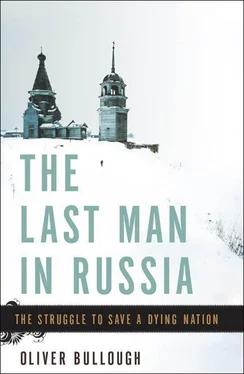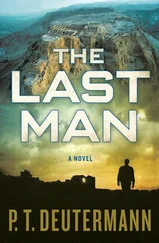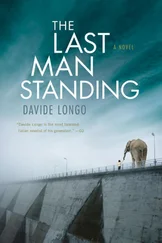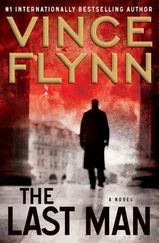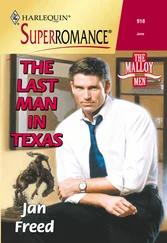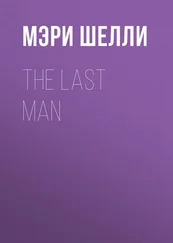From a cultural and social perspective, things were even worse. Or so I heard from Vasily Germangenovich Shpinkov, universally known as Germangenovich, from the village of Kazashchina. Kazashchina is a couple of kilometres to the west of Berezina. On my way to see him, I walked past a stork’s nest, a dense umbrella of sticks. Storks are supposed to bring good luck, but this one did not seem to have helped the village. Almost every house was boarded up or rotting.
Germangenovich was born in 1926, making him four years Father Dmitry’s junior. If he was busy when I arrived, he showed no sign of it, since he sat me down, squeezed on to the seat next to me and began to talk as if he had been waiting for me his whole life.
He had a strange twisted nose, scarred in the way I imagine a serious explosion would scar it. His grey hair was thick but chaotic. His eyes were bright. I had plenty of time to examine him since he believed in the bigger picture. His life story started with Peter the Great’s victory over the Swedes at Poltava. That was in 1709.
He was a Cossack and proud of it, and he pointed out to me his reproduction above the door of a painting in which Cossacks are shown writing a rude letter to the Turkish sultan. He wanted me to know that the tsars had been good people, and told me so at length. I had to write it all down, since he waited for me to do so after every sentence.
As a result, my notebook is full of pages of information on tsaristera serfs, when peasants were tied to their village and forced to give their labour to their lord for three days a week.
‘In 1931, Stalin brought in a second serfdom. He took the land, he took the livestock and he left the people with just a quarter of a hectare. And people did not have to work only three days a week for their masters like under the old system, but all the time, plus the churches and priests were destroyed.’
He was talking directly into my face, so I had a close view of his nose. His eyes were alive either side of it.
‘I remember how they forced people into the collective farm. The chairman of the village council sat at a table with a pistol which he said was for the enemies of the people, who were those who did not want to join the collective farm. I was six years old and was up on the stove.’
He gestured to the huge flat-topped stove that dominated the room. Traditional peasant houses such as this one are built around the stove. It projects into every room and keeps them warm in the wintertime. In very cold weather, the family sleeps on top.
When the chairman had finished his speech and everyone shouted ‘Praise Stalin, praise the revolution!’, Germangenovich’s grandmother told them they were all fools, that nothing good would come of it; that it was not for life, it was for death. Her curses made no difference. The government took over all the barns, and all the livestock. It even took people’s wedding rings, the state’s desire for currency was so strong.
‘We had to give our cow to the state, and my mother got two and a half metres of cloth, which she used to make shirts for my father. That was the payment for our cow: a couple of shirts. When my father took the horse to the collective farm, we cried, we children. He knew that the horse would die, because it would have no master, no one would look after it. Our horse went to the common barn, and they took our land, and this is where the starvation came from.’
There were seven people in his family: his parents, him, his three siblings and his grandmother. They ate herbs and weeds to stave off hunger. His father did not have the money to buy an exercise book, so they went semi-naked and barefoot to their lessons without anything to write in.
‘The children were weak, many could not go to school. They were naked and hungry, and refused to leave the house. How can you walk when your legs won’t move? At school, they gave out bread. They had a list, and they divided children up. The poorest got bread, but me and my brother were so-called middle peasants so we got nothing.’
Middle peasants were the group of people between kulaks – the supposedly rich oppressors, who were often ordinary farmers whose hard work had allowed them to own slightly more than their neighbours, and who were sent off to die in Siberia and the north – and the Bolsheviks’ favoured poor peasants.
The classifications were based on a report that Lenin wrote in the late nineteenth century. He was a committed Marxist, and saw the laws of class struggle all around him. That led him to the erroneous conclusion that peasants were dividing into classes – kulak, middle and poor – thanks to the government’s abolition of serfdom and various other limited agricultural reforms.
In fact, peasants distributed their land afresh every year, with families receiving a share proportional to the number of people in their household. That imposed equality and the differences Lenin observed were transient developments brought about by temporary increases in some families’ sizes that would be erased when young men left home or old men died.
The peasants he labelled as rich were rarely rich enough to employ labour, and in any case distrusted the habits required to get ahead in business. Besides, as Olga Semyonova Tian-Shanskaia noted, any surplus wealth tended to go on vodka, which had the habit of returning the relatively rich to the ranks of the poor once more.
Even if stratification into classes did occur, it was wiped out by the revolution and subsequent disturbances. Peasants stole their rich landlords’ belongings, then the Bolsheviks stole what was left. There were no kulaks, no middle peasants and no poor peasants. There were just peasants, and all of them were in dire condition.
For the Bolsheviks, however, what Lenin wrote was true, and the communist government set targets for how many kulaks needed to be ‘dekulakized’ so as to establish fairness in the countryside. In June 1931 alone, 101,184 families were resettled from their homes to remote areas. The population of the Narym territory in Siberia increased from 120,000 to 300,000 in less than three months as the kulaks poured in, with no allowances made to feed the new arrivals in the long Siberian winter.
The kulaks were often the peasants with the best handicraft skills. With their departure, the villages lost their most skilled and accomplished residents, as well as much of their livestock, since many peasants preferred to slaughter their animals rather than hand them over to the state. Lacking animals to work the land or supply manure for fertilizer, the peasants’ grain crops collapsed, while grain seizures continued. That caused a new famine.
Germangenovich cut a piece off the loaf of bread on the sideboard – 9 centimetres square, a bit bigger than a packet of cigarettes, though not as deep. That was the ration that he did not get. The bread was on a tray in school, and only the poor peasant children got any.
‘My brother asked for some and they refused him. So he just grabbed two bits of bread off the tray and ran. While they chased him, he ate one bit and the second he hid under his shirt and gave to me. That was a true brother.’
The government moved many of the villagers a few hundred kilometres into Ukraine, where there would apparently be work and food. They walked into the houses assigned to them, he said, to find the tables laid and the beds made. The Ukrainians had all died of hunger, and their fields were unworked.
In the winter of 1932–3, the death rate in some parts of Ukraine was thirteen times higher than normal. Russia was better off, but only just. In its worst-affected parts the death rate was nine times higher than normal.
In 1932–3, somewhere between 5 and 6 million people died, making it the worst single famine of the century until China surpassed it in 1958. Grain production that year was around 60 million tonnes, but the five-year plan demanded 106 million tonnes and the plan could not be changed, so grain seizures by officials continued despite the evidence of starvation. Desperate peasants fled the villages for the towns, where rations were better. The government, which had abolished internal passports with the revolution, sent the peasants back to their homes and reintroduced travel permits. Now only town-dwellers would have the right to live in towns, and peasants would be tied to the land by their lack of documentation. For Germangenovich, it was serfdom come again.
Читать дальше
